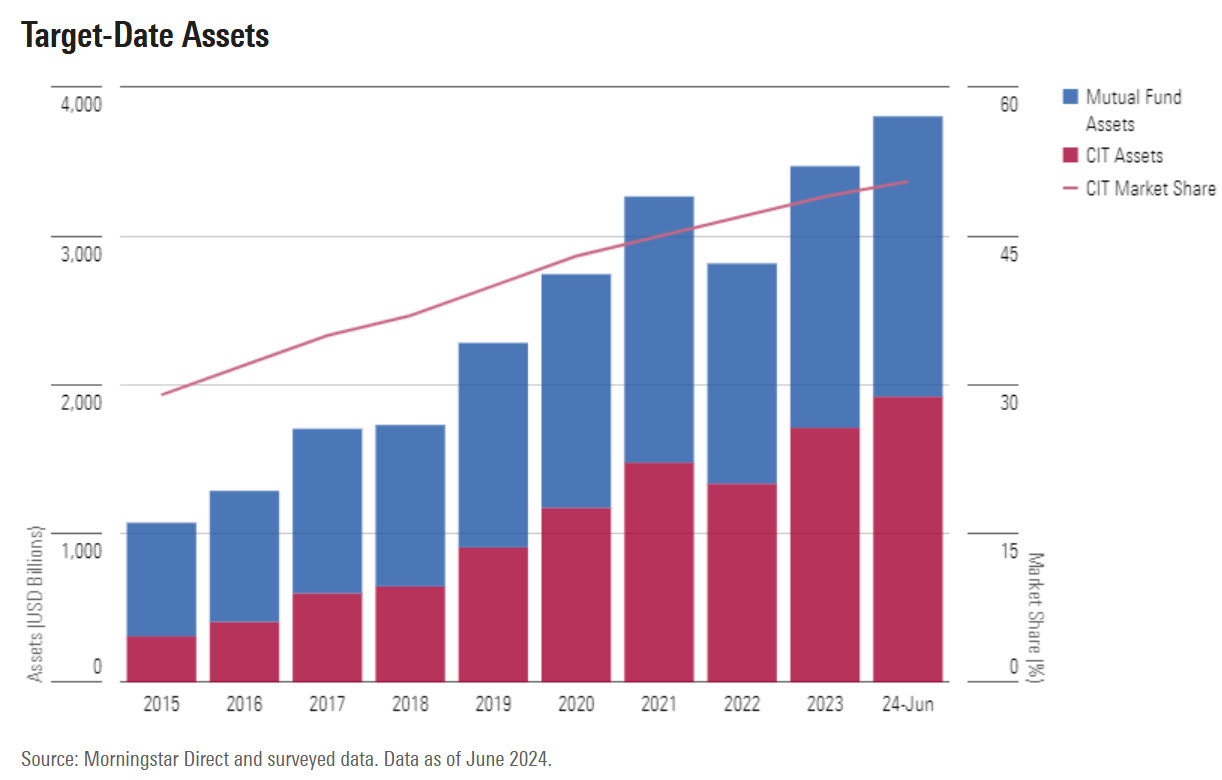
Most people saving for retirement have never heard of collective investment trusts (CITs), even though they may hold them in their employer-sponsored plans. This savings tool may offer many benefits over the mutual funds your employer might provide in your 401(k), with lower fees, added tax efficiency and flexibility. But it also comes with risks. Given how popular CITs are — they hold almost a third of the assets in defined contribution plans, worth about $7 trillion — you should give your retirement plan a once-over.
A CIT is an investment vehicle that pools investor funds to purchase a portfolio of investments, much like a mutual fund, but with some important differences. CITs are not traded on the stock market and are administered by banks or trust companies. They may even hold the same companies as a mutual fund, but CITs are almost always cheaper because they have lower regulatory and marketing requirements.
CITs are only available in qualified retirement plans, such as 401(k), 457(b), and federal Thrift Savings Plans. They may also become available to 403(b) plan participants starting in March 2025.
"CITs come in many different varieties," says Corbin Grillo, director of Investment Strategy with Linscomb Wealth. "For example, some may invest only in U.S. or international stocks, while others may focus on high-quality bonds. Additionally, qualified retirement plans often offer CITs that include a combination of different asset classes."
How to know if your 401(k) has a Collective Investment Trust
Since CITs aren't traded on open exchanges, they don't have ticker symbols like mutual funds or stocks. Instead, you can spot a CIT in your 401(k) by looking for the word "Trust" or the abbreviation "Tr" in the investment's name.
CITs don't publish prospectuses, but your retirement plan administrator should provide a fact sheet or profile of the CIT.
CIT target-date funds have eclipsed mutual funds
If you have a target-date fund in your retirement plan, you probably own a CIT. As of June 2024, CITs with target-date strategies represented 50.5% of target-date assets, according to Morningstar. Mutual funds made up 49.5% of target-date assets, down sharply from a decade ago.

CITs vs. mutual funds
CITs are similar to mutual funds in that both are pooled investment vehicles with holdings chosen to achieve a specific investment goal. However, the two are not the same.
Some of the key differences between CITs and mutual funds include:
- Access: Mutual funds are usually open to the general public, whereas you can only invest in a CIT through your retirement plan.
- Cost: "CITs generally have lower operational costs compared to similar mutual funds, and these savings are often passed on to investors through lower expense ratios," Grillo says. CITs may also have different fees based on how much you invest in the fund. According to a Morningstar study, "When comparing the net expense ratio of CIT tiers and mutual fund share classes of the same strategy, CITs are cheaper 91% of the time."
- Dividends: CITs are not required to pay out dividends or capital gains the way mutual funds must. Instead, the CIT may reinvest these earnings in the trust, which can help increase the investment's net asset value over time.
- Liquidity: CITs may have redemption restrictions, such as only allowing you to withdraw your funds on a monthly or quarterly basis. And you may not get your money back the next.
- Regulation: CITs are regulated by the Office of the Comptroller of the Currency (OCC) or a state banking regulator, whereas mutual funds are regulated by the Securities and Exchange Commission (SEC).
- Transparency: Since CITs aren't subject to the same regulation as mutual funds and often don't have ticker symbols, researching what's going on under the hood of these products can be challenging. Grillo says it may be harder to find details regarding a CIT’s holdings and management practices.
Pros and cons of CITs
The decision to invest in a CIT often depends on whether these investment vehicles can give you benefits that other options don't provide. For example, in addition to low fees, CITs may provide even greater flexibility and diversification than mutual funds.
"Managers of a CIT may be able to customize their investment strategy to better align with the objectives of retirement plan participants," Grillo says.
However, CITs are also less accessible than mutual funds. Because CITs are typically only available in employer-sponsored retirement plans, you likely won't be able to use the same CIT if you are rolling over your 401(k) into an IRA, Grillo says.
Depending on your objective, some features may be either a pro or a con. For example, the lack of dividend and capital gain distributions may be a benefit if you want to increase your position. But you may not appreciate this feature if you'd rather accumulate extra cash to invest in other assets.
Should you invest in a CIT?
You should follow the same decision process when considering a CIT as you would any other investment. Start by determining your investment goals.
"If a CIT, or combination of CITs, aligns with those goals, they could be the proper vehicle to use," Grillo says
A CIT could be a great addition to your portfolio if you're looking for a low cost, diversified asset. But it may not be a good fit if you think you're looking for income or need to make regular withdrawals from your portfolio.
Ultimately, it all comes down to personal preference. No investment vehicle is right for every investor. Every investment choice should be based around your needs, goal and time horizon.







